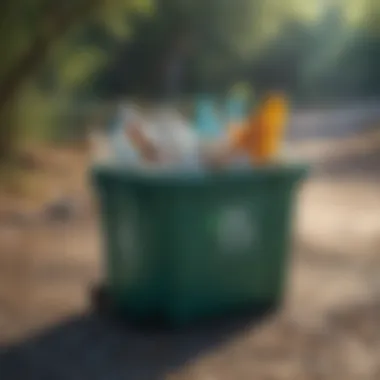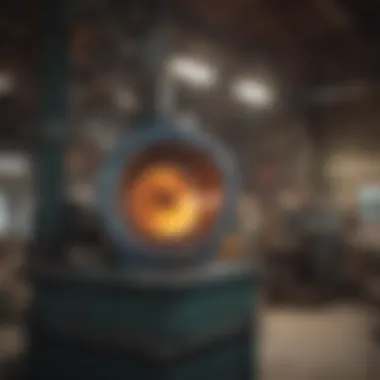Unveiling the Intricacies of Glass Recycling: Environmental Benefits and Challenges


Overview of the Topic
Glass recycling is a critical component of sustainable resource management and plays a vital role in reducing environmental impact. Recognizing the significance of recycling glass is essential in fostering a more eco-friendly approach to waste management. Through proper recycling practices, glass can be reused, helping to conserve natural resources and minimize energy consumption in the production of new glass items. Understanding the nuances of glass recycling is key to appreciating its benefits and addressing potential challenges that may arise.
Current Status and Challenges
The current state of glass recycling presents both opportunities and obstacles. While the recycling of glass contributes significantly to waste reduction and energy conservation, certain challenges persist. Contamination of recycled glass, inefficient collection systems, and lack of consumer awareness are among the primary obstacles hindering optimal glass recycling rates. Addressing these challenges requires a coordinated effort involving various stakeholders to enhance glass recycling infrastructure and promote widespread participation in recycling programs.
Sustainable Solutions
Exploring sustainable solutions to enhance glass recycling efficiency is crucial in overcoming existing challenges. Implementing innovative technologies, such as advanced sorting techniques and automated recycling processes, can improve the quality of recycled glass and streamline recycling operations. Additionally, promoting consumer education and awareness campaigns can encourage proper recycling practices and reduce contamination levels in recycled glass. Embracing sustainable practices in glass recycling is key to fostering a culture of environmental responsibility and resource conservation.
Impact and Importance
The impact of glass recycling extends beyond waste management, profoundly influencing ecosystems, communities, and future generations. By recycling glass, the demand for raw materials decreases, conserving natural resources and reducing carbon emissions associated with glass production. Furthermore, recycling glass helps mitigate landfill overflow, minimizing environmental degradation and preserving habitats. Recognizing the importance of glass recycling is essential in promoting sustainability, protecting the environment, and safeguarding the well-being of present and future populations.
This article explores the intricate process of recycling glass, shedding light on its significance in sustainable resource management. It delves deep into the various facets of glass recycling, encompassing the types of glass suitable for recycling and the methods involved in reprocessing. By elucidating the environmental benefits and challenges linked with glass recycling, this article aims to provide a comprehensive guide to understanding the overarching question of whether glass can be recycled.
Introduction
Glass recycling stands at the forefront of sustainable waste management practices, playing a pivotal role in conserving resources and reducing the environmental impact of glass production. Within the realm of recycling, glass holds a unique position due to its recyclable nature and the potential for endless reuse. The Introduction section elucidates the fundamental importance of glass recycling, setting the stage for a detailed exploration of its processes and implications for sustainable resource utilization.
Understanding Glass Recycling
The Importance of Recycling
The significance of glass recycling lies in its ability to mitigate the energy-intensive process of glass manufacturing. By recycling glass, we reduce the demand for raw materials, subsequently lowering energy consumption and cutting down on carbon emissions. Glass recycling also extends the lifespan of this material, promoting circular economy principles. This section delves into the tangible environmental benefits of glass recycling, emphasizing its role in conserving resources and fostering a more sustainable production ecosystem.


Types of Glass for Recycling
Glass intended for recycling encompasses various categories, including clear, colored, and heat-resistant glass. Each type poses distinct challenges and opportunities in the recycling process, influencing sorting and reprocessing methods. Clear glass, for instance, is preferred for recycling due to its high recyclability and minimal contamination issues. Conversely, colored glass requires specialized recycling techniques to maintain its quality and market value. By delving into the nuances of glass types for recycling, this section sheds light on the complexities involved in handling diverse glass compositions.
Process of Glass Recycling
Collection of Glass
The first step in glass recycling involves the collection of discarded glass containers from various sources, such as households, businesses, and recycling centers. Efficient collection systems ensure a steady supply of scrap glass for recycling facilities, minimizing reliance on virgin materials. Properly segregated glass collection streamlines the recycling process, enhancing the quality of recycled glass and reducing contamination levels. This section delves into the crucial role of effective glass collection practices in sustaining the glass recycling loop.
Sorting and Cleaning
Once collected, glass undergoes meticulous sorting to separate different glass types and remove contaminants such as labels, caps, and other non-glass materials. Sorting technologies play a vital role in automating this process, increasing precision and efficiency. Following sorting, the glass is cleaned to eliminate impurities and prepare it for reprocessing. The sorting and cleaning stage is critical in ensuring the purity and quality of recycled glass, making it suitable for various applications across industries.
Reprocessing Glass
Reprocessing glass involves melting down the cleaned glass cullet to form new glass products, a key step in the glass recycling loop. The molten glass can be shaped into new containers, fiberglass, or other glass products through molding or blowing techniques. Reprocessing reduces the energy requirements of glass production significantly, making it an eco-friendly alternative to virgin glass manufacturing. By elucidating the reprocessing phase, this section highlights the circular nature of glass recycling and its role in sustainable resource utilization.
Environmental Benefits
Glass recycling plays a crucial role in promoting sustainability and reducing environmental impact. By reusing glass, we contribute to a significant reduction in energy consumption and landfill waste. This process helps conserve raw materials and lowers carbon emissions, making it a vital component in the quest for a greener planet. The longevity of glass in landfills is remarkable, showcasing its durability and the potential for a decrease in overall waste volume.
Reducing Energy Consumption
Raw Materials Conservation
Raw materials conservation in glass recycling is essential for minimizing environmental footprint. By reusing existing glass, we eliminate the need for fresh resources, thus reducing energy consumption significantly. This conservation method not only preserves natural materials but also aids in curbing the ecological impacts of glass production. Its sustainable approach ensures a circular economy, creating a positive impact on resource sustainability.


Lower Carbon Emissions
Lowering carbon emissions is a core advantage of glass recycling. By reprocessing glass, we cut down on the energy required for manufacturing new products, resulting in reduced greenhouse gas emissions. This eco-friendly practice minimizes the carbon footprint associated with glass production and disposal. Lower carbon emissions from recycling contribute to a healthier environment and a more sustainable future.
Minimizing Landfill Waste
Longevity of Glass in Landfills
The enduring nature of glass in landfills is a significant benefit in waste management. Glass materials persist for an extended period without compromising quality, unlike other non-biodegradable substances that can take centuries to decompose. This longevity ensures that glass remains out of landfills for longer durations, reducing the need for additional storage space and limiting environmental repercussions.
Reduction in Waste Volume
Glass recycling substantially cuts down on waste volume in landfills. By diverting glass from conventional trash disposal, we decrease the overall waste accumulation, creating more eco-friendly waste management practices. This reduction in volume not only conserves landfill space but also minimizes harmful environmental impacts associated with excessive waste accumulation. Glass recycling's role in waste reduction is pivotal to sustainable waste management strategies.
Challenges in Glass Recycling
Glass recycling poses various challenges that are pivotal to address in the realm of sustainable resource management. Understanding and overcoming these hurdles are crucial for enhancing the efficacy of glass recycling initiatives. One prominent challenge is dealing with contamination issues, which can significantly impact the quality of recycled glass. Another key obstacle revolves around logistical constraints, encompassing transportation challenges and the availability of processing facilities. By delving deep into these challenges, we can uncover opportunities for innovation and improvement within the glass recycling sector, fostering a more environmentally sustainable future.
Contamination Issues
Mixed Material Waste
Mixed material waste presents a significant dilemma in the realm of glass recycling. This type of waste comprises a mix of various materials, including glass, plastics, and metals, making the sorting and processing of recyclables a complex and resource-intensive task. The key characteristic of mixed material waste lies in its heterogeneous composition, which complicates the recycling process and increases the likelihood of contamination. While mixed material waste can offer volume benefits in recycling efforts, its diverse nature poses challenges in achieving high-quality recycled glass. Balancing the advantages of bulk processing with the disadvantages of contamination underscores the intricate nature of mixed material waste recycling in sustainable resource management.
Quality of Recycled Glass
Ensuring the quality of recycled glass is paramount for promoting its reuse in manufacturing processes. The quality of recycled glass is defined by its cleanliness, purity, and compatibility with existing production standards. Maintaining a high-quality standard in recycled glass enhances its value as a secondary raw material, reducing the reliance on virgin resources and minimizing environmental impact. However, challenges such as residual contaminants, color impurities, and moisture content can compromise the quality of recycled glass, necessitating stringent quality control measures. Balancing the advantages of sustainability and resource conservation with the disadvantages of quality variability underscores the importance of prioritizing quality in glass recycling endeavors.


Logistical Constraints
Transportation Challenges
Transportation challenges play a pivotal role in the efficiency of glass recycling operations. The logistical aspect of transporting large volumes of glass waste from collection points to recycling facilities entails coordinating transportation routes, minimizing carbon emissions, and optimizing vehicle capacity. Key characteristics of transportation challenges include cost-effectiveness, timeliness, and environmental impact. While efficient transportation is essential for the viability of glass recycling programs, challenges such as long distances, inadequate infrastructure, and traffic congestion can impede smooth operations. Addressing transportation challenges involves leveraging advanced logistics solutions, promoting regional recycling hubs, and collaborating with transportation partners to streamline the recycling supply chain.
Processing Facilities
The availability and efficiency of processing facilities are critical components of successful glass recycling endeavors. Processing facilities encompass sorting, cleaning, and reprocessing units that transform collected glass waste into reusable cullet for manufacturing. Key characteristics of processing facilities include automation capabilities, material handling systems, and reprocessing technologies. While modern processing facilities offer advanced sorting mechanisms and energy-efficient processing techniques, challenges such as initial investment costs, maintenance requirements, and technological updates can impact operational sustainability. Optimizing processing facilities involves investing in state-of-the-art equipment, adopting best practices in glass recycling, and continuously upgrading infrastructure to meet evolving industry demands.
Future of Glass Recycling
Glass recycling is a crucial aspect of sustainable resource management. As a pivotal section in this article, the future of glass recycling holds immense importance. It is a topic that demands attention due to its potential to propel environmental conservation efforts further. Understanding the innovative pathways and strategies that can reshape glass recycling practices is paramount for ensuring a greener and cleaner future.
Innovations in Glass Recycling
Advanced Sorting Technologies
Advanced Sorting Technologies play a pivotal role in revolutionizing the efficiency and effectiveness of glass recycling processes. The key characteristic of these technologies lies in their ability to accurately segregate different types of glass based on color, transparency, and chemical composition. This precision ensures that the recycled glass meets stringent quality standards, enhancing its usability in various industries. One notable advantage of Advanced Sorting Technologies is their capacity to streamline the recycling process, reducing manual labor and increasing throughput significantly. However, like any technological advancement, these systems come with their set of challenges, such as initial installation costs and the need for periodic maintenance.
Alternative Uses for Recycled Glass
Exploring alternative uses for recycled glass is a promising avenue in the realm of sustainability. By identifying innovative applications for recycled glass beyond traditional remanufacturing, such as in construction materials or artistic endeavors, the scope for glass recycling widens considerably. The key characteristic of these alternative uses is their potential to reduce the demand for virgin materials while introducing unique aesthetic and functional properties to end products. Incorporating recycled glass into diverse industries not only fosters environmental conservation but also nurtures a circular economy model. However, challenges like limited market demand and the necessity for creative product design to accommodate recycled glass components remain prevalent.
Policy and Awareness
Policy and awareness initiatives play a pivotal role in shaping the landscape of glass recycling practices. These measures are essential for driving systemic change and promoting a culture of responsible resource management.
Government Initiatives
Government initiatives encompass a range of policies and regulatory frameworks aimed at incentivizing and regulating glass recycling activities. The key characteristic of these initiatives is their legal backing, which imposes requirements on businesses and individual households to participate in recycling programs. By offering subsidies, tax incentives, or establishing mandatory recycling targets, governments can significantly boost recycling rates and reduce the environmental impact of glass waste. However, challenges such as compliance enforcement and monitoring effectiveness persist as practical considerations.
Promoting Recycling Culture
Promoting a recycling culture is crucial for fostering long-term sustainability practices among communities. The key characteristic of such initiatives is their emphasis on education, outreach programs, and public engagement to instill responsible waste management behaviors. By raising awareness about the benefits of recycling glass and providing convenient disposal options, recycling culture initiatives seek to change societal attitudes towards waste. Encouraging individuals to embrace recycling as a social responsibility and environmental commitment is a gradual but transformative process. Yet, challenges like overcoming apathy and ingrained habits towards waste disposal pose significant obstacles to widespread behavioral change.



